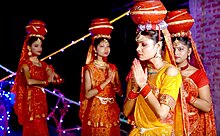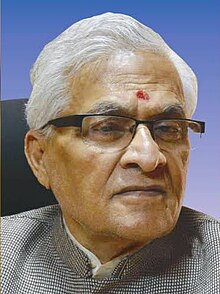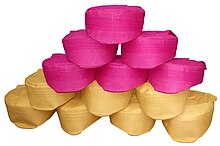Maithils
 Women performingJhijhiya,the traditional dance of Mithila | |
| Total population | |
|---|---|
| c. 16.8 million | |
| Regions with significant populations | |
| India | 13.6 million (2011 Census)[1] |
| Nepal | 3.2 million (2021 Census)[2] |
| Languages | |
| Maithili HindiandNepali[3] | |
| Religion | |
| Majority: Minority: | |
| Related ethnic groups | |
| Magahi·Bhojpuris·Awadhis | |
Maithils(Devanagari:मैथिल), also known asMaithili people,are anIndo-Aryanethno-linguistic group from theIndian subcontinent,who speak theMaithili languageas their native language.[4]They inhabit theMithila region,[5]which comprises Northern and EasternBiharand NortheasternJharkhandin India[6][7]and some adjoining districts of Nepal constitutingMadhesh Provincein addition to some terai districts ofBagmatiandKoshi Provinces.[8]
The Maithil region forms an important part of Hinduism as it is said to be the birthplace ofSita,the wife ofRamand incarnation ofLakshmi.[9]
History
Vedic period
Mithila first gained prominence after being settled byIndo-Aryanspeaking peoples who established theVidehakingdom. During the late Vedic period (c. 1100–500 BCE), Videha became one of the major political and cultural centers of South Asia, along with Kuru and Pañcāla. The kings of the Videha Kingdom were calledJanakas.[10]
The Videha Kingdom later became incorporated into theVajjika Leaguewhich was based inVaishali.[11] TheLicchavis of Vaishaliwere one of the constituent tribes of the Vajjika league and the territory of the Licchavis formed a single territorial unit along with Videha andMallakas.The Licchavis remained in Vaishali up to the Gupta period with the fourth century A.D. Gupta Emperor,Samudragupta,being the son of a Licchavi princess from Vaishali.[12][13]
Medieval period
From the 11th century to the 20th century, Mithila was ruled by various indigenous dynasties. The first were theKarnatas of Mithilawho ruled from 1097-1324 A.D. They were followed by theOiniwar dynastywho ruled from 1325–1526 A.D.[14]
During theMughal-era,Mithila was controlled by a dynasty of zamindars called theRaj Darbhangawho were tributaries to the Mughals.[15]It was during this period that the capital of Mithila was moved toDarbhanga.[16][17]
Maithili-speaking dynasties and kingdoms
- Karnat dynasty,1097 CE–1324 CE[18]
- Oiniwar dynasty,1325 CE–1526 CE[19]
- Raj Darbhanga,1557 CE −1947 CE[20]
- Malla dynasty,1201 CE-1779 CE[21]
- Senas of Makwanpur,1518 CE –1762 CE[22]
Region
India

Majority of Maithils normally reside north of theGanges;based aroundDarbhangaand the rest of North Bihar.[24][4] Native Maithili speakers also reside inDelhi,Kolkata,Patna,RanchiandMumbai.[25]
Indian Mithila comprisesDarbhanga,Kosi,andPurniadivisions of Bihar.[6][4]
Darbhangain particular played an important role in the history of Mithila and is considered one of its "core centers". It was the center ofRaj Darbhangawho ruled most of the region.[4][26] Madhubani was also whereMadhubani paintingsoriginated from which is a major part of Maithil culture.[27] Sitamarhi is claimed by many to be the birthplace of GoddessSitawithSita Kundbeing a major pilgrimage site. Baliraajgadh, situated in present-dayMadhubani districtin Bihar is thought to be the capital of ancientMithila Kingdom.[28] Maithils played a major role in building theBaidyanath Templewhich is an important pilgrimage site for them.[29][30]
Nepal

The adjoining districts of the easternTeraiform Nepalese Mithila.[31]This area was part of the kingdom ofVideha.[32]The kingdom appears in theRamayana.Many people claim Janakpur to be the birthplace of Goddess Sita but this is disputed as many considerSitamarhias her birthplace.[33]
There was a movement in theMadhesh regionwhich is predominantly a Maithili andBhojpurispeaking region of Nepal for a separate province.[34]Province No. 2was established under the 2015 Constitution, which transformed Nepal into a Federal Democratic Republic, with a total of 7 provinces. Province No. 2 (nowMadhesh Province) has a Maithili speaking majority and consists of most of the Maithili speaking areas of Nepal. It has been demanded by some Mithila activists that Province No. 2 be named 'Mithila Province'.[35]Province no. 2 was given the nameMadhesh Provinceon 17 January 2022.[36]
Language

The common language of the Maithil people isMaithili,[4]which is one of the recognised regional languages ofIndiaand the second national language ofNepallisted in the Eighth Schedule of theIndian Constitutionand theInterim Constitution of Nepal.TheTirhuta script,also known as the Mithilakshar script andKaithiscript was used as the original script of the language. However, during the 20th century most Maithili writers gradually adopted Devanagari script for Maithili.[38]Some traditionalpanditsstill use Tirhuta script forpātā(ceremonial letters related to important functions, such as marriage).
Culture
Men and women in Mithila are very religious and dress for festivals as well. The costumes of Mithila stem from the rich traditional culture of Mithila.KurtaandDhotiwith aMithila PaintingborderedMaroon coloured Gamchhawhich is the Symbol of Passion, Love, Bravery and Courage are common clothing items for men. Men wear a Gold ring on their nose which symbolizes prosperity, happiness and wealth inspired byLord Vishnu.Also, wear a Balla on their wrist andMithila Paagon their Head. In ancient times there was no colour option in Mithila, so the Maithil women wore white or yellow Saree with a red Border but now they have a lot of variety and colour options and wearLaal-Paara(the traditional red-boarded white or yellowSaree)[39]on some special occasions, and also wearShakha-Pola[40]with a lanthi in their hand which is Mandatory to wear after marriage in Mithila. In Mithila culture, this represents new beginnings, passion and prosperity. Red also represents the Hindu goddessDurga,a symbol of new beginnings and feminine power. During Chhaith, the women of Mithila wear pure cotton dhoti without stitching which reflects the pure, traditional Culture of Mithila. Usually crafted from pure cotton for daily use and from pure silk for more glamorous occasions, traditional attire for the women of Mithila includes Jamdani, Banarisi, Bhagalpuri and many more. Many festivals are celebrated throughout the year in Mithila.Chhath Puja,Durga PujaandKali pujais celebrated as perhaps the most important of all the celebrations of Mithila.

Household structure
Traditionally Maithils lived inBadagharscalledlonghouseswith big families of many generations, sometimes 40–50 people. All household members pool their labour force, contribute their income, share the expenditure and use one kitchen.[41]
Religion
The religious practices of the Maithils is based on orthodoxHinduismas Mithila has historically been a principal seat of Hindu learning.[42]
Politics
Maithils hold significant influence in the politics of both India and Nepal. They dominate the polity of Bihar, India's third most populous state, by virtue of their majority in 144 of the 243 constituencies of theBihar Legislative Assembly.[4][citation needed]Maithils are the largest ethnolinguistic group in the NepaleseMadhesh Provinceand the second largest ethnolinguistic group inProvince No. 1.[43]
Notable people
The following are notable residents (past and present) of Mithila region:
Historical


- Janaka,King of Mithila and Father in Law of KingRama
- Sita,Princess ofMithila Kingdomand wife of KingRama
- Udayanacharya,10th/11th-century philosopher andlogicianof theNyayaschool.
- Vidyapati,14th/15th century Maithili and Sanskrit poet-saint
- Bhanudatta Misra,15th/16th-centurySanskritpoet from Mithila
- Harisimhadeva,King of Mithila during theKarnat dynastyfrom 1304 - 1324 CE
- Gangadeva,King of Mithila during theKarnat dynastyfrom 1147-1187 CE
- Narsimhadeva,King of Mithila during theKarnat dynastyfrom 1174-1227 CE
- Ramasimhadeva,King of Mithila during theKarnat dynastyfrom 1227-1285 CE
- Jyotirishwar Thakur,14th-centurypoet,playwrightandmusicianwho composed the earliest prose work in theMaithili language,theVarna Ratnakara
- Caṇḍeśvara Ṭhakkura,political theorist and general from the 14th century
- Gaṅgeśa,13th/14th centuryphilosopher,logicianandmathematician
- Pakshadhara Mishra,15th-century philosopher
- Vāchaspati Misra,9th/10th-century philosopher of theAdvaita Vedantatradition
- Lakshmeshwar Singh,zamindar and principal landowner ofRaj Darbhanga,1860–1898
- Rameshwar Singh,zamindar and principal landowner ofRaj Darbhanga,1898–1929
- Śāriputra,15th-century Indian Buddhist monk and the last abbot of theMahabodhi TempleinBodh Gaya.Born inSimraungadhin modern-dayEast Champaran district
Modern
- Maghfoor Ahmad Ajazi,IndianFreedom fighter,political activist, social worker, poet and writer, born inMuzaffarpur[44][45]
- Bimalendra Nidhi,Member of Nepalese parliament, Vice president of ruling partyNepali Congressand formerDeputy Prime Minister of Nepal.[46]
- Ramdhari Singh 'Dinkar'was anIndianHindipoet, essayist, patriot and academic.[47]
- Bindheshwari Prasad Mandalwas an Indian parliamentarian and social reformer who served as the chairman of the Second Backward Classes Commission (popularly known as theMandal Commission).[48]
- C. K. Raut,formerly US-based computer scientist, author and political leader of Nepal.[49]
- Syed Shahnawaz Hussain,Indian politician, born inSupaul[50][51][52]
- Bhagwat Jha Azadwas the Chief Minister ofBiharand a member ofLok Sabha.[53]
- Ram Baran Yadav,First president of Nepal
- Tarkishore Prasad,Deputy Chief Minister of Bihar,born inSaharsa district[54]
See also
References
Notes
- ^"Census of India 2011"(PDF).Office of the Registrar General & Census Commissioner, India.2011. p. 7.Retrieved24 September2024.
- ^"National Population and Housing Census 2021"(PDF).Census of Nepal.2021. p. 32.Retrieved24 September2024.
- ^"Demographics of Maithil population of Nepal".
- ^abcdefKumar Jha, Mithilesh (2017).Language Politics and Public Sphere in North India: Making of the Maithili Movement.Oxford University Press. pp. 37–45.ISBN9780199091720.
- ^Burman, B.K.R.; Chakrabarti, S.B. (1988).Social Science and Social Concern: Felicitation Volume in Honour of Professor B.K. Roy Burman.Mittal Publications. p. 411.ISBN9788170990628.Retrieved14 February2017.
- ^abJha, Pankaj Kumar (2010).Sushasan Ke Aaine Mein Naya Bihar.Bihar (India): Prabhat Prakashan.ISBN9789380186283.
- ^Brass, Paul R. (8 September 1994).The Politics of India Since Independence.Cambridge University Press. p. 184.ISBN9780521459709.Retrieved15 February2017.
- ^Gellner, D.; Pfaff-Czarnecka, J.; Whelpton, J. (2012).Nationalism and Ethnicity in a Hindu Kingdom: The Politics and Culture of Contemporary Nepal.Taylor & Francis. p. 251.ISBN9781136649561.Retrieved14 February2017.
- ^Minahan, J.B. (2012).Ethnic Groups of South Asia and the Pacific: An Encyclopedia: An Encyclopedia.ABC-CLIO.ISBN9781598846607.Retrieved14 February2017.
- ^Michael Witzel(1989),Tracing the Vedic dialects in Dialectes dans les litteratures Indo-Aryennesed. Caillat, Paris, pages 13, 141–143
- ^Raychaudhuri Hemchandra (1972), Political History of Ancient India, Calcutta: University of Calcutta, pp. 85–86
- ^Jha, Hit Narayan (1970).The Licchavis of Vaishali.Chowkhamba Sanskrit Series. pp. 14–15.
- ^Trautmann, Thomas (1972)."Licchavi-Dauhitra".The Journal of the Royal Asiatic Society of Great Britain and Ireland.104(1): 2–15.doi:10.1017/S0035869X0012951X.JSTOR25203320.
- ^Jha, Makhan (1997).Anthropology of Ancient Hindu Kingdoms: A Study in Civilizational Perspective.M.D. Publications Pvt.ISBN9788175330344.Retrieved11 December2016.
- ^Henning Brown, Carolyn (1988)."Raja and Rank in North Bihar".Modern Asian Studies.22(4): 757–782.doi:10.1017/S0026749X00015730.JSTOR312524.S2CID143084073.
- ^Mandal, R. B. (2010).Wetlands management in North Bihar.Concept Publishing Company.ISBN9788180697074.Retrieved14 December2016.
- ^Jha, Makhan (1997).Anthropology of Ancient Hindu Kingdoms: A Study in Civilizational Perspective.M.D. Publications Pvt.ISBN9788175330344.Retrieved14 December2016.
- ^Sinha, CPN (1969). "Origin of the Karnatas of Mithila – A Fresh Appraisal".Proceedings of the Indian History Congress.31:66–72.JSTOR44138330.
- ^Pankaj Jha (20 November 2018).A Political History of Literature: Vidyapati and the Fifteenth Century.OUP India.ISBN978-0-19-909535-3.
- ^Tahir Hussain Ansari (20 June 2019).Mughal Administration and the Zamindars of Bihar.Taylor & Francis. pp. 200–223.ISBN978-1-00-065152-2.
- ^Brinkhaus, Horst (1991). "The Descent of the Nepalese Malla Dynasty as Reflected by Local Chroniclers".Journal of the American Oriental Society.111(1): 118–122.doi:10.2307/603754.JSTOR603754.
- ^Das, Basudevlal (2013)."Maithili in Medieval Nepal: A Historical Apprisal".Academic Voices.3:1–3.doi:10.3126/av.v3i1.9704.
- ^Gellner, D (2012).Nationalism and Ethnicity in a Hindu Kingdom: The Politics and Culture of Contemporary Nepal.Routledge. p. 260.ISBN978-1-136-64956-1.
- ^(India), Bihar; Choudhury, Pranab Chandra Roy (1957)."Bihar district gazetteers, Volume 17".p. 16.Retrieved10 December2016.
- ^MaithilsatEthnologue(16th ed., 2009)

- ^Jha, Makhan (1997).Anthropology of Ancient Hindu Kingdoms: A Study in Civilizational Perspective.M.D. Publications Pvt. p. 62.ISBN9788175330344.Retrieved10 December2016.
- ^Madhubani paintings.Abhinav Publications. 2003.ISBN9788170171560.Retrieved10 December2016.
- ^"नालंदा ने आनंदित किया लेकिन मिथिला के बलिराजगढ़ की कौन सुध लेगा? – News of Bihar".NewsOfBihar.com.16 July 2016. Archived fromthe originalon 26 October 2017.Retrieved26 October2017.
- ^Narayan, Sachindra (1 June 1983)."Sacred Complexes of Deoghar and Rajgir".Concept Publishing Company – via Google Books.
- ^Kumāra, Braja Bihārī (1998).Small States Syndrome in India.Concept Publishing Company. p. 146.ISBN9788170226918.Archivedfrom the original on 17 February 2017.Retrieved16 February2017.
- ^Bolduc, Benjamin; Hodgkins, Suzanne B.; Varner, Ruth K.; Crill, Patrick M.; McCalley, Carmody K.; Chanton, Jeffrey P.; Tyson, Gene W.; Riley, William J.; Palace, Michael; Duhaime, Melissa B.; Hough, Moira A.; Saleska, Scott R.; Sullivan, Matthew B.; Rich, Virginia I. (13 August 2020)."Supplemental Information 3: An excerpt from Data Downloads page, where users can download original datasets".PeerJ.8:e9467.doi:10.7717/peerj.9467/supp-3.
- ^Michael Witzel(1989),Tracing the Vedic dialectsinDialectes dans les litteratures Indo-Aryennesed.Caillat,Paris, pages 13, 17 116–124, 141–143
- ^Gellner, D.; Pfaff-Czarnecka, J.; Whelpton, J. (6 December 2012).Nationalism and Ethnicity in a Hindu Kingdom.Routledge.ISBN9781136649561.Retrieved8 December2016.
- ^Burkert, C. (2012)."Defining Maithil Identity".In Gellner, D.; Pfaff-Czarnecka, J.; Whelpton, J. (eds.).Nationalism and Ethnicity in a Hindu Kingdom: The Politics and Culture of Contemporary Nepal.London, New York: Routledge. pp. 241–273.ISBN9781136649561.Archivedfrom the original on 20 August 2017.
- ^"Samiti vows to protest for Mithila Province".
- ^"Province 2 endorses Madhes as its name, Janakpurdham as provincial capital".kathmandupost.com.Retrieved2022-04-28.
- ^Jyotiśvara. (1998).Varṇa-ratnākara of Jyotiriśvara of Kaviśekharācārya.New Delhi: Sahitya Akademi. pp. ix.ISBN81-260-0439-8.OCLC40268712.
- ^Chaudhary, Pranava (May 22, 2011)."US scholar's project of encoding Tirhuta script into digital media".The Times of India.Archivedfrom the original on April 5, 2012.Retrieved26 July2013.
- ^Maithil women wore Red Boarded Yellow or White Saree during Jhijhiya Naach.Retrieved27 March2017.
- ^"Mithila as well as Bengal wearing शाखा पोला" www.jhajistore.com ".Retrieved12 August2019.
- ^Lam, L. M. (2009)."Park, hill migration and changes in household livelihood systems of Maithils in Central Nepal"(PDF).University of Adelaide. Archived fromthe original(PDF)on 2011-09-28.
- ^Vidyabhusana, Satis Chandra (1988).A History of Indian Logic: Ancient, Mediaeval and Modern Schools.Motilal Banarsidass Publishers.ISBN9788120805651.Retrieved8 December2016.
- ^"Official status sought for Maithili in Province 2".26 December 2017.
- ^Ministry of Culture, Government of India."Maghfoor Ahmad Ajazi".amritmahotsav.nic.in.
- ^Sajjad, Mohammad (6 January 2013)."Maghfur Aijazi: A freedom-fighter and a builder of Indian democracy".TwoCircles.net.Retrieved5 March2015.
- ^"Nidhi appointed NC Vice-Prez, Khadka Gen Secy".kathmandupost.com.Retrieved2022-01-15.
- ^"Ramdhari Singh Dinker - Hindi ke Chhayavadi Kavi".www.anubhuti-hindi.org.Retrieved2020-04-26.
- ^Nitish Kumar and the Rise of Bihar.Penguin Books India. 2011-01-01.ISBN9780670084593.
- ^""मुख्य समाचार":: नेपाल:: ".Ekantipur.com. 24 May 2015. Archived fromthe originalon 4 July 2015.Retrieved28 May2015.
- ^IANS (10 December 2013)."BJP's Shahnawaz Hussain on IM hit list".Business Standard India.Archivedfrom the original on 26 October 2017.Retrieved26 October2017– via Business Standard.
- ^"BJP leader Shahnawaz Hussain's impersonator arrested".NDTV.com.Archivedfrom the original on 19 December 2013.Retrieved26 October2017.
- ^"PM's 'lack' of leadership has made UPA 'sinking ship': BJP".NewIndianExpress.com.Archived fromthe originalon 4 March 2016.Retrieved26 October2017.
- ^"8th Lok Sabha – Members Bioprofile – AZAD, SHRI BHAGWAT JHA".Archived fromthe originalon 6 October 2011.Retrieved6 August2011.
- ^"I want self-reliant Bihar; Sushil Modi is our guardian, says new deputy CM Tarkishore Prasad".19 November 2020.
Bibliography
- Alan R. Beals & John Thayer Hitchcock (1960)."Field Guide to India".India: National Academies.
